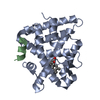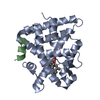Entry Database : PDB / ID : 4m8eTitle CRYSTAL STRUCTURE OF HUMAN RETINOID X RECEPTOR ALPHA-LIGAND BINDING DOMAIN COMPLEX WITH (S) 4-Methyl 9cUAB30 COACTIVATOR PEPTIDE GRIP-1 Nuclear receptor coactivator 2 Retinoic acid receptor RXR-alpha Keywords / / / / / / / / / / / / / / / / / / Function / homology Function Domain/homology Component
/ / / / / / / / / / / / / / / / / / / / / / / / / / / / / / / / / / / / / / / / / / / / / / / / / / / / / / / / / / / / / / / / / / / / / / / / / / / / / / / / / / / / / / / / / / / / / / / / / / / / / / / / / / / / / / / / / / / / / / / / / / / / / / / / / / / / / / / / / / / / / / / / / / / / / / / / / / / / / / / / / Biological species Homo sapiens (human)Method / Resolution : 2.4 Å Authors Xia, G. / Smith, C.D. / Muccio, D.D. Journal : Bioorg.Med.Chem. / Year : 2014Title : Methyl-substituted conformationally constrained rexinoid agonists for the retinoid X receptors demonstrate improved efficacy for cancer therapy and prevention.Authors : Desphande, A. / Xia, G. / Boerma, L.J. / Vines, K.K. / Atigadda, V.R. / Lobo-Ruppert, S. / Grubbs, C.J. / Moeinpour, F.L. / Smith, C.D. / Christov, K. / Brouillette, W.J. / Muccio, D.D. History Deposition Aug 13, 2013 Deposition site / Processing site Revision 1.0 Jan 22, 2014 Provider / Type Revision 1.1 Jul 17, 2019 Group / Refinement description / Category Item _software.contact_author / _software.contact_author_email ... _software.contact_author / _software.contact_author_email / _software.language / _software.location / _software.name / _software.type Revision 1.2 Aug 17, 2022 Group / Derived calculationsCategory database_2 / pdbx_struct_assembly ... database_2 / pdbx_struct_assembly / pdbx_struct_assembly_gen / pdbx_struct_assembly_prop / pdbx_struct_oper_list / struct_site Item _database_2.pdbx_DOI / _database_2.pdbx_database_accession ... _database_2.pdbx_DOI / _database_2.pdbx_database_accession / _pdbx_struct_assembly.details / _pdbx_struct_assembly.method_details / _pdbx_struct_assembly.oligomeric_count / _pdbx_struct_assembly.oligomeric_details / _pdbx_struct_assembly_gen.oper_expression / _struct_site.pdbx_auth_asym_id / _struct_site.pdbx_auth_comp_id / _struct_site.pdbx_auth_seq_id Revision 1.3 Feb 28, 2024 Group / Category / chem_comp_bond
Show all Show less
 Yorodumi
Yorodumi Open data
Open data Basic information
Basic information Components
Components Keywords
Keywords Function and homology information
Function and homology information Homo sapiens (human)
Homo sapiens (human) X-RAY DIFFRACTION / Resolution: 2.4 Å
X-RAY DIFFRACTION / Resolution: 2.4 Å  Authors
Authors Citation
Citation Journal: Bioorg.Med.Chem. / Year: 2014
Journal: Bioorg.Med.Chem. / Year: 2014 Structure visualization
Structure visualization Molmil
Molmil Jmol/JSmol
Jmol/JSmol Downloads & links
Downloads & links Download
Download 4m8e.cif.gz
4m8e.cif.gz PDBx/mmCIF format
PDBx/mmCIF format pdb4m8e.ent.gz
pdb4m8e.ent.gz PDB format
PDB format 4m8e.json.gz
4m8e.json.gz PDBx/mmJSON format
PDBx/mmJSON format Other downloads
Other downloads 4m8e_validation.pdf.gz
4m8e_validation.pdf.gz wwPDB validaton report
wwPDB validaton report 4m8e_full_validation.pdf.gz
4m8e_full_validation.pdf.gz 4m8e_validation.xml.gz
4m8e_validation.xml.gz 4m8e_validation.cif.gz
4m8e_validation.cif.gz https://data.pdbj.org/pub/pdb/validation_reports/m8/4m8e
https://data.pdbj.org/pub/pdb/validation_reports/m8/4m8e ftp://data.pdbj.org/pub/pdb/validation_reports/m8/4m8e
ftp://data.pdbj.org/pub/pdb/validation_reports/m8/4m8e
 F&H Search
F&H Search Links
Links Assembly
Assembly

 Components
Components Homo sapiens (human) / Strain: P19793 / Gene: NR2B1, RXRA / Production host:
Homo sapiens (human) / Strain: P19793 / Gene: NR2B1, RXRA / Production host: 
 Homo sapiens (human) / References: UniProt: Q15596
Homo sapiens (human) / References: UniProt: Q15596 X-RAY DIFFRACTION / Number of used crystals: 1
X-RAY DIFFRACTION / Number of used crystals: 1  Sample preparation
Sample preparation ROTATING ANODE / Site:
ROTATING ANODE / Site:  APS
APS  / Beamline: 22-ID / Type: OTHER / Wavelength: 1.5418 / Wavelength: 1.315 Å
/ Beamline: 22-ID / Type: OTHER / Wavelength: 1.5418 / Wavelength: 1.315 Å Processing
Processing Movie
Movie Controller
Controller




 PDBj
PDBj














